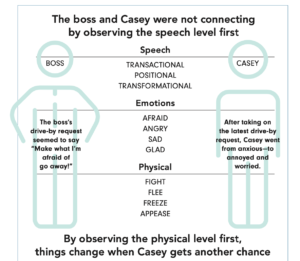Today’s fast-paced work environments require speed and agility in every conversation—from face-to-face conversations, to emails and texts, and to the virtual meetings we attend. Yet, most companies are sending their employees to meet this twenty-first century challenge armed with dated communication skills and standards.
Company leaders will invest billions in information technology to enable people to collaborate across multiple time zones and then be shocked when projects fail. They shouldn’t be surprised. A recent study from the Project Management Institute determined that one-third of all projects fail because of poor communication and ineffective listening.
I know what it’s like to be on projects that fail from my 25-year career as a technology manager. Failure dissolves team trust and erodes the ability to respond quickly to changing conditions.
I also know what it’s like to be on projects that succeed, when people exchanged the right information at the right time in the right ways.
Robert Dunham, the Executive Director of the Institute for Generative Leadership, made a direct connection between project outcomes and conversations when he wrote:
“All the outcomes we experience, both individually and socially, come from our conversations: the conversations we have, the ones we don’t have, the conversations we do well, and the ones we do poorly.”
If you want better outcomes, you need better conversation skills. Most people think that the best way to improve their conversations is to be better with words. I’ve found that the quickest way to improve conversations is to improve the quality of listening. After all, a conversation is a combination of speaking and listening.
Listening is more than hearing the words correctly. It is also paying attention to what is happening physically and emotionally during the conversation. I call this kind of listening Deep Listening.
To illustrate this, I want to share the story of one of my clients who was able to produce better results and increase job satisfaction by listening to their boss in a whole new way.
Casey was an IT Manager for a Fortune 500 company who came to me for help with handling the boss’s “drive-by requests.” These were always urgent and personally delivered as the boss was on the way to an important meeting.
Casey would try, unsuccessfully, to engage the boss in conversations to get more details and to understand how this new #1 priority ranked against the other #1 priorities given earlier in the week.
“The more questions I would ask, the more my boss would get a ‘deer in the headlights’ look,” Casey told me.
“We would have this awkward silence where I’d hope for an answer. In the end, I would just say ‘yes’ and then wonder what I just said ‘yes’ to.”
Deep listening is the ability to observe what is happening physically, emotionally, and with speech between you and another person as the conversation is happening.
Level 1 of Deep Listening: Observe the body
Your body produces physical reactions in response to your environment. It is constantly scanning the environment for tasty treats to eat, or threats to your safety. If it detects a reward, your brain sends signals to your body to approach and consume. If it detects a threat, whether it’s physical or emotional, your brain sends signals to the rest of your body to prepare to fight, flee, freeze or appease. As soon as these “threat” signals are sent, your ability to reason effectively is switched off.
These signals make sense from an evolutionary point of view. Taking time to think could result in death if you’re being chased by a predator. If you take your eye off the reward, it may be eaten by someone else.
You can increase the possibility of producing a desired outcome by paying attention to your body. By observing and calming your own physical state, you can influence the physical state of your conversation partners.
Level 2 of Deep Listening: Observe emotions
Your emotions create energy to take physical action. If the bio-reactions are automatic, you will likely repeat an old pattern. Your brain searches for an experience in your past with a similar sensation signature. When it finds a match, it then takes the energy you experienced from that time, brings it into the present, and projects what will happen into the future.
Observing emotions can be overwhelming for a beginner. There are so many of them! As a start, you can look for the four base emotions that underlie all our emotions, as outlined by scientists at the University of Glasgow’s Institute for Neuroscience and Psychology: fear, anger, sad, and glad.
You constantly communicate your emotions to others through your body language, vocal tone, and facial expressions. By observing and shifting your own emotional energy, you can influence the emotional energy of your conversation partners.
Level 3 of Deep Listening: Observe speech
Your speech signals intention and coordinates action with others. Linguists John Austin and John Searle pointed out these basic actions people perform with words:
• Express opinions
• Declare what is or is not factual in our world
• Ask people to do things for us
• Commit to do things for others
You communicate your intentions and coordinate action with others through three types of conversations as outlined below by organizational anthropologist Judith D. Glaser in her book Conversational Intelligence.
Three Types of Speech
| Type | Definition | Example |
| Transactional | Ask – Tell | Please pass the salt. |
| Positional | Advocate from a role | I authorize you to proceed. |
| Transformation | Share a vision for what is possible | Will you marry me? |
By observing how you speak with your conversation partners, you can clarify understandings and respond to changes, and make desirable outcomes more likely.
Deep Listening means learning to observe from the bottom up
If you find yourself in a situation like Casey’s where you feel you aren’t connecting with another person, shift your attention to the bottom level—physical—and work your way up. Here’s how the three levels of deep listening showed up in my work with Casey.
I asked Casey, “What did it feel like in your body when you saw that ‘deer in the headlights’ look?”
“I felt anxious,” Casey replied. “Like I’m supposed to make it go away.”
“And what kind of look does your boss have after you say ‘yes’?” I inquired.
“Relieved,” Casey said.
“And how do you feel after your boss leaves your office?” I asked.
“I feel a bit annoyed and worried.”
I paused for a moment and said, “Well, then, it looks like your boss successfully delegated the anxiety to you.”
I pointed out to Casey that the boss’s problem wasn’t going to be solved entirely on the speech level. Casey wanted to have a transformational conversation with the boss by inquiring about the desired results. However, Casey’s boss wanted to have a transactional conversation, in effect, demanding “Make what I’m afraid of go away!”
To solve Casey’s boss’s problem would require shifting to the physical level to address the bio-reactions that are signaling threat, and to the emotional level to deal with the feeling of fear. I introduced Casey to this deep listening practice to learn to listen at all three levels, working from the bottom up.
 Physical level (bottom)
Physical level (bottom)
• Imagine there is a pause button you can hit to stop the rushing thoughts and feelings
• Press your imaginary pause button
• Bring your attention to your breath and notice how you are breathing
• Breathe in and out a little more deeply and slowly than you currently are (Try an inhale and exhale for eight counts)
Emotion level (middle)
• Ask yourself if you are: afraid, angry, sad, or glad
• Bring to your attention a prior experience where you were glad and try to recreate in the present moment, the physical and emotional sensations that accompanied feeling glad in the past
• Be curious about how you can bring that experience into your conversation
Speech level (top)
• Determine which speech action will be the most effective
• Choose the conversation type that will produce the outcome you seek
• Have a conversation with the person who can help you produce the outcome you want
Casey gets another chance
After practicing this deep listening approach, Casey told me about another “drive-by request” with a successful outcome.
“My boss stopped by my office and told me I needed to take care of something right away. I noticed that I was startled after taking a quick inhalation.
I remembered to take a slow deep breath and was surprised to see that as I calmed down, I stood up from my desk and slowly walked to meet my boss. As I approached, I smiled and said, ‘Sure, what’s up?’
I wanted it to be clear that I had my boss’s back. That seemed to lower the tension a bit.
I learned that there was a critical customer meeting in the morning and my boss wanted to be prepared for any questions that could come up.
Rather than ask more questions that could ratchet up anxiety, I offered to write up a summary of what I knew about the customer issue and to attend the meeting to answer any additional questions. I mentioned that the relevant report I had been working on would be available one day later.
Then I asked, ‘Would that be good enough for now?’
My boss smiled and said that would be a good start.
I’m glad that I was able to deal with my boss’s urgent request without worrying about it all night.”
Quick Tips
1. Hit the pause button
2. Ask yourself what you’re feeling physically
3. By calming your own physical state, you can influence the physical state of your conversation partners
Conclusion
Casey successfully averted sharing the boss’s anxiety by hitting the pause button first (physical), communicated a collaborative intention next (emotion), and advocated from their role with a solution that met their boss’s immediate needs (speech). In addition, Casey was able to keep working on the relevant report until completion without feeling rushed or anxious.
Experience the three levels of deep listening
Deep listening is just one of the skills that enable agile conversations that lead to better outcomes. If you would like to learn more about how to build communication skills to meet twenty-first-century challenges, please book a call today.











